Earth Lodges
Earth dwellings have been in use for as long as people have been
building shelters, and are still in use today. Native Americans
once created earth lodges that were mostly underground, circular
in construction and will dome roofs.
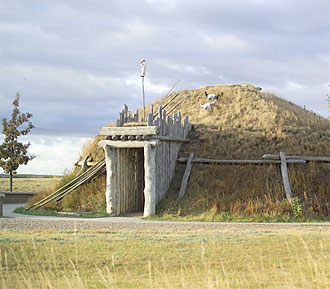 Earth Lodge
Earth Lodge |
|
Ancient as well as modern earth lodges use soil as an integral
component in order to create a thermally-effective structure.
The dwelling may be earth-bonded, in which soil is used to insulate
one or more of the building's elevations.
Alternatively, the structure
could be earth-covered, in which earth is used
to insulate the roof of the building, or the building could be
built into a hill, with only one side exposed in order to provide
light and passive or active solar heat. Sometimes the entire dwelling
is built below-grade, with light and ventilation provided by means
of a central atrium.
There are several benefits to earth lodges. The structure is
protected from the elements, offers privacy, makes effective use
of available land and is naturally sound-proofed. It is very energy-efficient
because the earth naturally absorbs heat and then retains it.
Changes in temperature occur slowly, so the structure is easy
to keep warm in the winter and remains cool in the hotter months.
One problem with earth-sheltered housing is that water seepage
can occur. To prevent this, vents can be placed in the roof or
along the walls. Environmentalists typically appreciate the low
energy requirements of earth dwellings, but find the fact that
many of them are made with plastic and other non-biodegradable
materials somewhat problematic.
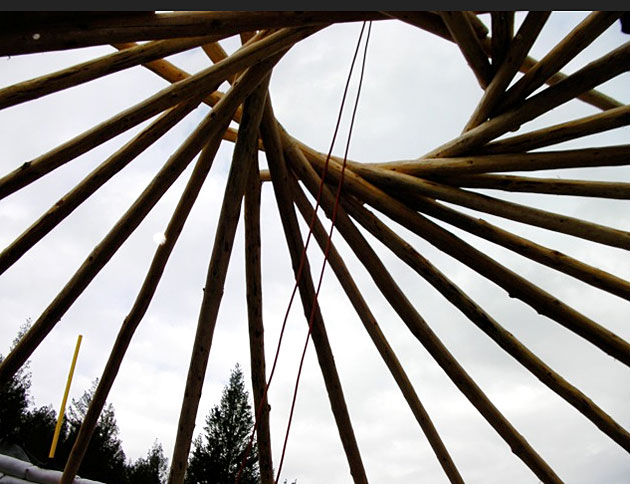
Earth Lodge Construction
Site planning is very important
to the overall design of an earth lodge. On relatively
flat land, a house that is fully recessed is a very effective
design. Where the land slopes, the dwelling can be set directly
into the hill. The "window wall" is generally located
on the southern exposure in order to fully maximize the passive
solar capabilities of the design.
Where temperatures are extreme, the earth's natural insulating
capabilities can provide comfort. Wind is a factor to be considered.
Typically there are few windows in an earth dwelling, so it is
important to know the intensity and direction of the wind in order
to take advantage of natural ventilation. In areas where winter
winds are extreme, sufficient vegetation should be left around
the dwelling in order to provide a natural wind-break.
It is also essential to
consider the type of soil when planning the dwelling.
The best type of soil for drainage is a mix of gravel and sand.
If the soil has a high clay content, drainage can be problematic.
If the area is prone to frost heave, the foundation should be
situated below the frost line. Waterproofing is essential, generally
consisting of a layer of liquid asphalt. Additionally, foam or
insulation board should be placed on the outside of the waterproof
layer.
When designing an atrium, it is important to make sure that the
earth slopes away from the building on each side. A drain pipe
along the edge of the roof can also divert water from the structure.
The most common material used in constructing an earth lodge
is reinforced concrete. Wood is not suitable because of its tendency
to rot when exposed to earth. The problem with reinforced concrete
is that it is not environmentally sustainable, but the concrete
industry is developing more earth-friendly products in response
to the public's increased demand for eco-friendly construction.
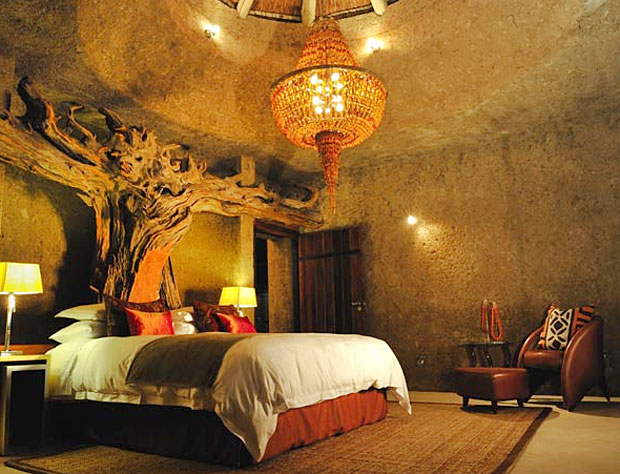
Modern Luxury Earth Lodge Interior
The earth dwelling differs
from conventional housing in that the insulation
is applied to the exterior of the house rather than the interior.
This is to enable the shelter to maintain its appropriate temperature.
Polystyrene sheets or spray foam can be used. The foam works
exceptionally well for structures that are unconventional, such
as rounded dwellings. In some areas, insulation will not be required,
but if the temperatures range from very hot to very cold, insulation
will be essential.
Benefits of Creating an Earth lodge
The majority of earth lodges are circular in shape. They feature a dome-shaped roofing system, and a central smoke hole at the apex. An earth lodge is most commonly associated with Native American tribes of the Great Plains and Eastern Woodlands.
The tribes most commonly associated with earth lodges are the Hidatsas, Arikaras, Mandans, Omahas, Poncas, Otoes, and Pawnees. In the early 1500s, ancestors of the Mandans and Arikaras built the first real earth lodges in Missouri River communities in central North Dakota and northern South Dakota.
Earth lodges are also common at Mississippian sites across the eastern United States. Having said that, the aim of this article is to give you insights into the unique advantages of creating an Earth Lodge.
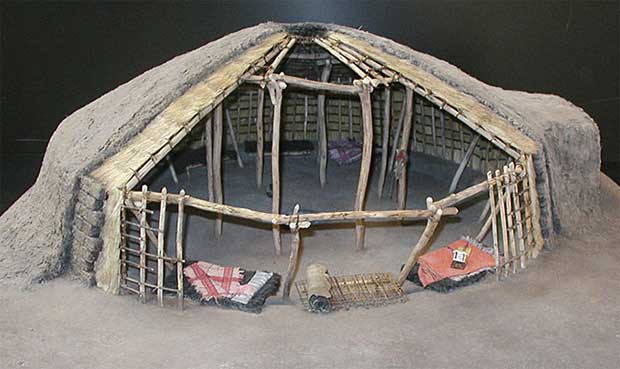
Pawnee Earth Lodge
Why You Should Create an Earth Lodge
It may appear strange to build an earth lodge for those who have never done so. However, like any home design, this construction method has a number of practical advantages, including energy efficiency, cost savings, and the conservation of natural resources. Let’s take a look at the advantages of earth lodges.
Protection From Weather Hazards
An earth lodge is built in such a way that there's nothing above ground that could be damaged. Structurally, they are very strong. Consequently, an earth lodge is less susceptible to incremental weather such as hurricanes, tornadoes, earthquakes, hailstorms, high winds, and winter. In the event of an earthquake, for example, an earth lodge built further into the ground yet on a fault line will have reduced amplitude and vibrations.
Cheaper Insurance Costs
An earth lodge is less expensive to insure than a conventional house. This is because it provides more protection from high winds, hailstorms, and natural disasters like tornadoes and hurricanes.
Energy Conservation and Constant Indoor Temperature
The earth's insulation allows an earth lodge to maintain a consistent temperature of 55-60°F during the summer and winter months. In hot weather, it can absorb more heat from the home. In cold winter, on the other hand, it can insulate the house to keep it warm. Consequently, your earth lodge will not require as much heating or air conditioning, which in turn, reduces energy costs.
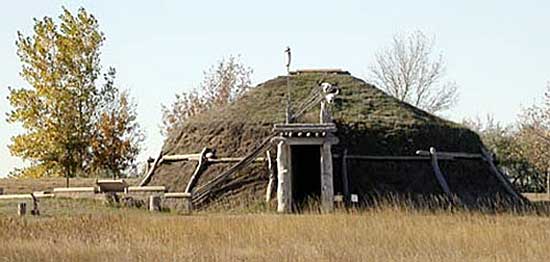
Simple Earth Lodge
Privacy
An earth lodge offers more privacy than a conventional home. For example, an earth lodge has few windows. Therefore, maintaining privacy is easy. Furthermore, most of the home is underground. As a result, passers-by will not be able to see what is happening in your home.
Low Maintenance
An earth lodge requires little to no external materials. Furthermore, an earth lodge requires less outside maintenance. You will not be required to clean the roof or re-roof.
Longevity
The vegetation and soil on the roof of an earth lodge can withstand harsh weather conditions, as well as temperature fluctuations and UV rays. Consequently, earth-covered roofs tend to last up to three times longer than traditional roofing systems.
Eco-Friendly
Besides incorporating the earth, the earth lodge is eco-friendly due to its non-invasive nature on the local flora and fauna. In other words, the natural environment or landscape is not affected by the presence and construction of a conventional building. Furthermore, the soil or green roof of an earth lodge can absorb and filter rainwater, before it evaporates into the atmosphere. Consequently, rainwater does not flow into sewer systems. This prevents flooding because 90% of the water is captured.
Provides Soundproofing
The earth surrounding an earth lodge adequately reduces external noise from neighbors, vehicles, and other sources. Therefore, your earth lodge will be comfortable and tranquil.
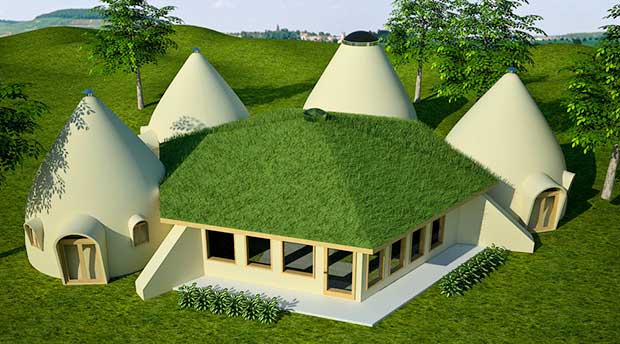
Modern Earth Lodge
Conclusion
In the long term, creating an earth lodge can save you lots of money. This is because an earth lodge does not require central heating or cooling. Other benefits include low maintenance, less noise, and lower insurance costs. What are you waiting for – why not build your dream earth lodge today?
|

